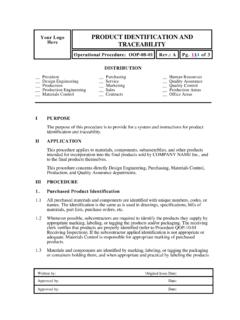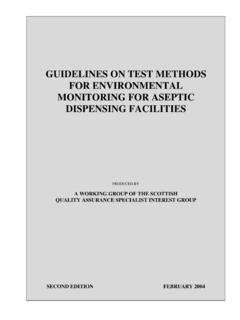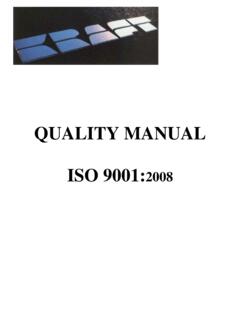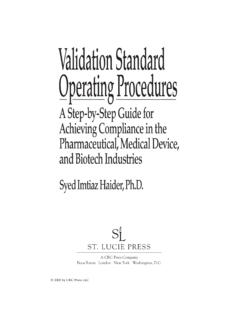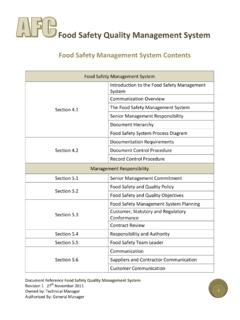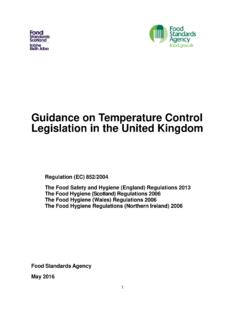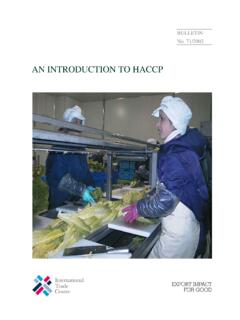Transcription of HACCP audit checklist Requirement Details Y/ N ...
1 HACCP audit checklist Requirement Conformity Details Y/ N. Prerequisite Program Management Commitment 1. Senior management ensures that the responsibilities and authorities are defined and communicated within the company Internal Communication 1. There is a clear communication and reporting channel between senior management and personnel. Management Review 1. Management review includes: o audit results o customer feedback o process performance and product conformity o status of preventive and corrective action o follow-up action from previous management reviews o planned changes that could affect the quality system o recommendations for improvement Quality Manual 1. A quality manual with appropriate processes and procedures exists control of Documents 1.
2 Document control procedures are in place including approval for adequacy prior to use, updates and re-approval, identification of the current version, availability, legibility 2. Records are controlled (identifies which records are needed and how long they are kept). 3. The following records are maintained as appropriate to the product ( GMPs, production records, master record file). Internal audit 1. Internal audits are performed on scheduled intervals to assess the effectiveness of the QMS. 2. Personnel identified and trained to perform internal audits 3. Documentation that corrective and preventive actions were performed as an outcome of the internal audit Site standards 1. Procedures exist for the review and evaluation of food safety hazards in the event of new or changed facilities 2.
3 Buildings and grounds are adequately and routinely maintained 3. Buildings are maintained in a reasonably clean and orderly manner 4. Buildings are of suitable construction to minimize access to rodents, birds, and other pest 5. Buildings provide adequate space and lighting 6. All equipment maintained in a reasonably and orderly manner 7. All equipment are of suitable size, design, construction, precision, and accuracy for its intended use 8. All equipment is maintained to prevent lubricants and coolants introduction as unsafe additives to food 9. All equipment designed, constructed, and maintained to facilitate inspection and use of cleanout procedures 10. Work areas and equipment used for the manufacture and storage of food are kept separate from chemicals 11.
4 All equipment is properly cleaned to prevent unsafe contamination of food 12. There are procedures in place controlling calibration of equipment 13. There is a master sheet of all equipments Purchasing 1. Evidence that ingredient specifications are provided to suppliers exists 2. Traceability procedures exist to facilitate product recall 3. Established inspection procedures or other inspection activities to ensure that purchased material specifications are in place, including contamination control of production 1. Master record file is maintained for each product which includes product specifications, formulation, label, and special manufacturing instructions 2. Frequency and number of samples needed during production for each batch 3. Proper identification and date of manufacture are provided 4.
5 Production records are maintained that provide formulation, date of production, date of shipment to facilitate recall procedures 5. Work instructions for proper manufacturing procedures are available to personnel 6. Production records are inspected for accuracy at scheduled intervals 7. Equipment is suitable for manufacturing of product to specification 8. Monitoring devices are available and used Validation of production process 1. Validation procedures are in place and conform to science based performance standards Identification and traceability 1. Finished product is properly packaged and labelled for identification and should include name, product description, net weight (or bulk statement), lot number, shelf life date, and all label regulatory requirements 2.
6 Procedures for product traceability are documented 3. Retained samples are identified for traceability (shelf life). control of monitoring and measuring devices 1. Monitoring and measuring devices used to manufacture product is properly maintained, calibrated, and recorded 2. Instrumentation and devices used to calibrate monitoring and measuring devices are verified at specified intervals against Monitoring and measurement of processes 1. Monitoring procedures have been established to evaluate the manufacturing processes, where appropriate 2. Scheduled monitoring activities have been established. Monitoring and measurement of product 1. Procedures are in place to ensure product conforms to Requirement Storage of Product 1. Products are properly identified, stored, handled, and controlled to maintain their identity and integrity Customer satisfaction 1.
7 Procedures for recording and evaluating complaints exist. control of non-conforming product 1. Procedures to control non-conforming product have been established 2. Non-conforming product is properly identified and stored in specified location 3. Documentation of final disposition of non-conforming product, which may include rework and re-verification 4. Procedures have been established for product recall or customer notification if non-conforming product is detected after delivery 5. Procedures to handle returned goods are established 6. Documented procedures that establish requirements for reviewing and preventing non-conformities including customer complaints, determine reason for nonconformity, take action to prevent reoccurrence of nonconformity, records of results of actions taken, and reviewing corrective action taken Training 1.
8 Records are available that demonstrate personnel competence and training 2. Job descriptions are available that include the responsibility and skills required by the employee 3. Personnel are properly trained in personal hygiene where appropriate to avoid contamination 4. Training matrix is in place 5. Re-freshing training procedure is in place 6. Training records are available for personnel dealing with CCPs. HACCP . 1. The HACCP team has been trained and the training has been recorded a) Include names of the HACCP team and training/job experience which qualifies the individuals in the application of HACCP principles b) The individual developing the hazard analysis , including delineating control measures successfully completed training in the application of HACCP principles.
9 C) The individual developing a HACCP plan that is appropriate for a specific site successfully completed training in the application of HACCP principles. d) The individual verifying and modifying the HACCP plan successfully completed training in the application of HACCP principles. e) The individual performing the record review successfully completed training in the application of HACCP principles. 2. The HACCP plan is specific to the location and site 3. The HACCP plan is specific to the ingredient, food or process 4. If ingredients, food or processes are grouped together in a single plan, evidence exists that they share common hazards 5. The hazard analysis lists all hazards a) The written hazard analysis (which may be in table form) identifies hazards for each process step or includes the statement none identified at this time.
10 B) The written hazard evaluation is science-based, considers hazard frequency and severity and has been performed for every identified hazard. c) The control measures for significant hazards have been identified. d) Prerequisite programs exist for significant hazards and are correctly referenced in the HACCP plan e) The hazard analysis procedure included an evaluation of SOPs and modifications were performed if necessary f) critical control points exist for significant hazards g) The hazard analysis considers external and internal hazards h) Evidence exist that the HACCP team considered, as a minimum, biological, chemical and physical hazards listed in this section . i) The hazard analysis considered possible sources of adulteration including all process steps including packaging, storage, transportation, intended use, facility and equipment function and design, and plant sanitation including human hygiene.




